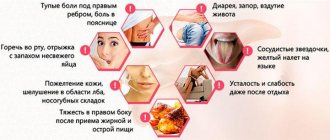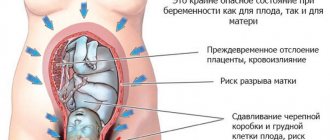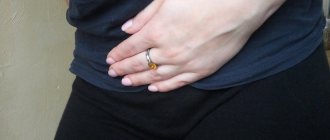Every person has felt pain in the side on the right side, right under the ribs, at least once in their life. This is not necessarily a sign of a serious illness - even a completely healthy person can suddenly develop pain in the right side. The explanation for these pains, which lies on the surface, is the high density of contact of the hypochondrium with the organs that are located on the right side and the peculiarity of their structure. But if the symptom repeats repeatedly, the pain is severe, you must urgently consult a doctor to make a clear diagnosis.
Pain in the right side under the ribs
Main causes of pain ↑
As a rule, pain in the right side is a sign of the presence of diseases of the abdominal cavity (liver, pancreas, gall bladder and bile ducts, right kidney, hepatic flexure of the colon), spine, and chest organs.
This pathology can be therapeutic (not requiring urgent medical intervention) or emergency.
Therapeutic conditions
On the right side under the ribs and nausea
These symptoms are a characteristic sign of chronic or acute pancreatitis.
Discomfort occurs when the head of the pancreas becomes inflamed, and the pain itself spreads beyond the area of inflammation and radiates to the back.
As a rule, with this condition the patient feels general weakness and malaise, and suffers from digestive disorders.
Dull pain in the right side and nausea are also accompanied by inflammatory processes in the liver:
- cirrhosis;
- hepatitis (acute; chronic);
- tumors.
Characteristic signs of the presence of such diseases, in addition to the typical dull pain, are:
- yellowness of the skin;
- pallor and weakness;
- nausea and dyspeptic disorders;
- general malaise;
- decreased appetite.
Pain in the right side under the ribs after eating is accompanied by duodenitis.
In this case, the pain radiates to the back and shoulder blade. Patients are concerned about nausea and vomiting, digestive disorders, weakness and sweating, and belching with bitter air.
On the right side under the ribs and bitterness in the mouth
These symptoms are often caused by diseases of the gallbladder and bile ducts.
As a rule, pain radiates to the right shoulder, the patient feels heaviness in the hypochondrium on the right side, weakness, malaise, and sometimes suffers from vomiting.
Dull, stabbing pain
This type of pain may be associated with chronic cholecystitis and the presence of gallstones.
A characteristic feature of this disease is the cyclical nature of pain: unpleasant sensations appear frequently and are related to meals.
Diet helps prevent pain, reduce its frequency and intensity.
Photo: gallbladder with stones
Another possible cause of dull pain is gallbladder dyskinesia.
The course of this disease, caused by a violation of the contractility of the organ, is also accompanied by aching or stabbing pains, which also disappear with diet and proper drug treatment.
In the right hypochondrium and belching
These symptoms may be characteristic signs of cholangitis (inflammation of the bile ducts) and bulbitis (inflammation of the proximal duodenum).
Fig.: cholangitis
Right side under the ribs and diarrhea (constipation)
These symptoms may indicate gastritis.
Painful sensations with this disease appear a couple of hours after eating or in the morning, on an empty stomach.
An additional symptom is belching with sour air.
Emergency conditions
Often, the presence of pain in the right side is a symptom of the presence of health and life-threatening (so-called surgical) diseases for which the patient needs emergency care.
Acute cholecystitis
This is an acute inflammation of the gallbladder, the symptoms of which are:
- sharp pain in the right side, radiating to the neck, right shoulder and shoulder blade;
- a sharp increase in temperature;
- chills;
- weakness;
- nausea and repeated vomiting.
The occurrence of the disease is associated with the presence of stones in the gall bladder, which block the passages and prevent bile from leaving.
This is fraught with rupture of the gallbladder, peritonitis and even death.
Liver diseases
In such cases, the pain is sharp, stabbing, paroxysmal, and has the character of hepatic colic, which is caused by the presence of stones or spasm, tumor, or adhesions.
Obstructed outflow of bile leads to excessive stretching of the gallbladder. As a rule, this condition is accompanied by repeated vomiting.
Kidney diseases
Pain is also accompanied by inflammatory processes in the kidneys and urolithiasis.
The nature of the pain in this case is not local: it radiates to the genitals and back.
Often such diseases are accompanied by urinary retention, nausea and weakness.
Photo: urolithiasis
Localization of pain in the right hypochondrium sometimes occurs with acute pyelonephritis - inflammation of the right kidney. In this case, the disease is accompanied by impaired urination.
Acute appendicitis
This condition often causes pain in the right hypochondrium.
Despite the fact that the source is located in the lower abdomen, the pain is reflected and begins to be felt under the ribs and in the upper abdomen, misleading the patient.
Heart and lung diseases
Pain in the hypochondrium is a common symptom in diseases of the chest organs:
- pericarditis;
- myocardial infarction;
- right-sided pleurisy.
Additional symptoms will help identify the problem area.
Diseases of the chest organs usually cause fever, shortness of breath, weakness, and frequent and painful cough. Pain when swallowing and hiccups are accompanied by pleurisy.
Pain on the right under the ribs sometimes occurs with acute pneumonia.
Fig.: pleurisy
A correct diagnosis can be made by examining other symptoms:
- cough with sputum and pus;
- the presence of high temperature and previous hypothermia.
Tumors and injuries
Pain can be caused by changes in the size of the diaphragm due to pressure from other organs, hernia, tumors of the diaphragm and its ruptures due to abdominal injuries.
Pain in the right hypochondrium can be caused by injuries:
- rib fracture;
- liver damage;
- rupture of the kidney, gall bladder.
However, pain in the right hypochondrium can occur due to physical activity unusual for the body, sharp bends, turns, or contact of internal organs with the ribs.
During pregnancy
Pregnant women deserve special attention: pain in their right side under the ribs can be either associated with diseases of the internal organs or not caused by them at all.
In expectant mothers, pain most often occurs due to the enlargement of internal organs and their displacement within the abdominal cavity.
To exclude pathology, in case of frequent and prolonged pain in the hypochondrium, pregnant women are recommended:
- undergo examination by a specialist;
- according to his instructions, take blood and urine tests;
- do an ultrasound examination of the abdominal organs.
Why does hygroma occur? How to get rid of it? You can find a lot of information on this topic in our article on the treatment of hygroma of the wrist joint. For what reason can a nerve in the back suddenly become pinched? Read here.
Help with pain in the right side under the ribs
Of course, without being a doctor, it is impossible to accurately determine the cause of the pain. Therefore, the patient’s primary task is to understand at least the nature of the cause. Is it physiological or pathological? If there is menstruation, jogging on a full stomach and other phenomena that can cause physiological pain, if the pain is not very disturbing and passes quickly, it may be worth waiting and not taking emergency measures. With the disappearance of the physiological cause, the pain will also disappear.
But if everything repeats, intensifies, persists for a long time, and is accompanied by accompanying symptoms, there is only one piece of advice - immediately seek medical help.
If the pain persists, you should consult a doctor
Advice. The doctor you can contact in case of aggressive pain: therapist, gastroenterologist, oncologist, surgeon - depending on the nature of the existing pathology.
While waiting for medical help, you can take the following steps yourself.
- Reduce pain by taking antispasmodics (if the pain is very severe, paradoxically, it is not recommended to take medications in order to maintain a clear clinical picture until the ambulance arrives).
- Apply a cold compress (not hot!) to the sore spot.
- Take a comfortable position in which the least pain is felt, and wait for an ambulance.
You can use an ice bag to make a cold compress.
If the diagnosis is established and drug treatment is prescribed, folk remedies can help in recovery and relief from pain:
- spleen diseases - rosehip decoction;
- liver diseases – honey and half cinnamon;
- gallbladder disease - a decoction of potatoes boiled in their jackets.
Rose hip decoction
Preventive actions
They exist. To avoid sharp pain in the right hypochondrium and not end up on the operating table, you need to follow a dietary regime and adhere to a healthy lifestyle.
- Moderate physical activity.
- No alcohol abuse.
- Proper nutrition, without excessive amounts of spicy, fatty, salty foods.
- Seek advice at the very beginning of pain.
- Annual examination of internal organs, especially with alarming heredity.
Proper nutrition will help maintain healthy organs
Pain under the right rib may be a temporary phenomenon that occurs several times and will not bother you again, or it may indicate a serious illness that has already “settled” in your body. It is important to prevent its development, aggravation of the situation and consequences that could be disastrous. That is why, even once experiencing pain that is unusual for you, on the right side under the ribs, you should be wary and listen to your body. Nausea, stomach pain, read our article.
What could be the nature of the pain? ↑
Based on the nature of the pain, you can find out what disease is causing the discomfort. Thus, severe pain is accompanied by diseases of the liver, kidneys, gallbladder and bile ducts.
Discomfort accompanied by heaviness, nausea and vomiting
Discomfort occurs when:
- cholecystitis;
- hepatic colic;
- cirrhosis;
- urolithiasis;
- acute hepatitis.
This nature of pain forces a person to look for a comfortable position, and any shift causes sharp sensations.
Fig.: liver cirrhosis
The patient suffers from vomiting, dyspeptic disorders, and often bloating.
In diseases of the biliary tract and gallbladder, pain appears after eating fried, fatty foods.
With renal colic, the pain does not subside even at rest.
The localization of pain is under the ribs at the back, but it can change, causing the pain to move to the abdominal area.
Liver pathologies are accompanied not only by pain in the right hypochondrium, but also by noticeable heaviness, a change in the color of urine to the color of beer, and the appearance of yellowness of the skin and sclera of the eyes.
Aching pain in the right hypochondrium
Characteristic of biliary dyskinesia. As a rule, this disorder is accompanied by bitterness in the mouth, weakness and fatigue, impaired appetite, and apathy.
Often a dull aching pain is a symptom of gallstone disease.
Aching and nagging pain in the right hypochondrium often occurs due to eating disorders and congestion in the biliary tract.
Sometimes such pain occurs during physical activity.
The reasons for the manifestation may be:
- chronic pyelonephritis;
- polycystic right kidney;
- chronic pancreatitis;
- inflammation of the right kidney, right lung;
- parasitic diseases of the biliary tract and liver.
Stitching pains
Often bothers people while running.
The reason for this is stretching of the liver capsule.
It occurs due to a decrease in blood outflow, disruption of the diaphragm due to improper breathing.
To prevent discomfort, it is necessary to warm up before exercise, ensure proper breathing, take deep breaths and breathe from the stomach.
In this case, the help of a doctor is not necessary.
Right-sided pneumonia is also accompanied by stabbing pain.
In this case, the patient suffers:
- dyspeptic disorders;
- shortness of breath;
- characterized by an increase in temperature;
- cyanosis of the nasolabial triangle.
Figure: pneumonia
Stitching pain also occurs with pathologies of the right kidney.
Sharp sharp pain
This type of pain is paroxysmal in nature and manifests itself in hepatic colic, usually at night.
This type of pain is also observed in renal colic, which is associated with the passage of a stone through the ureter.
Sharp pain in the right hypochondrium can be a symptom of rupture of the gallbladder, fallopian tube, cyst, ovary, appendicitis, acute pyelonephritis.
Acute pain occurs with a stomach or duodenal ulcer.
In this case, the patient suffers from dyspeptic disorders, nausea and vomiting, heartburn and belching.
Photo: peptic ulcer
Pain in the right hypochondrium can also be caused by vegetative-vascular dystonia, and their nature is variable.
Intense pain is characteristic of acute cholecystitis.
Dull constant pain
Often associated with diseases of the liver and pancreas:
- hepatitis A;
- inflammation of the head of the pancreas;
- tumors;
- intoxication of the body;
- increased liver size;
- inflammation of the gallbladder.
Girdle pain
This pain can be caused by:
- disruption of the liver, gall bladder, pancreas;
- development of pleurisy;
- neuralgia.
If the pain is sharp and stabbing, this is a symptom of acute pancreatitis. This pain is intense and does not subside even at rest.
In addition, this disease is accompanied by:
- repeated vomiting;
- cyanosis of the skin;
- “marbling” of the skin of the abdomen;
- small hemorrhages around the navel and on the sides.
Sharp pain
In such cases, it is better to immediately contact a medical facility. The presence of acute pain indicates possible conditions:
- Cholecystitis. Unexpected and sharp pain, if it occurs in the middle of the night, signals obstruction of the biliary tract. The sensations are sharp, short-term and provoked by nervous overstrain.
- Exacerbation of ulcers. Stitching pain occurs more often at night, relief occurs after food enters the digestive system. Complemented by symptoms such as bloating and heaviness, hyperthermia and malaise, an acute abdomen is noted.
- Blockage of bile ducts by stones. Stagnation of bile is formed, which is accompanied by pain, nausea, vomiting and hyperthermia of the right hand.
- Gynecological abnormalities. Sudden pain in women due to amenorrhea indicates an ectopic pregnancy. If the causes of pain are: inflammation of the appendages and torsion of the ovarian cyst, urgent hospitalization is recommended.
- Renal colic. In this case, the person needs emergency medical care, since a severe attack can only be relieved with complex medications, treatment with antispasmodics and painkillers.
- Pancreatitis. Discomfort begins with a throbbing pain that gradually encircles and haunts you in any position of the body. In this case, urgent consultation with a doctor is required.
See also: Symptoms and treatment of food poisoning
Diagnosis of pain ↑
It is possible to determine what causes the pain by specifying the location of the pain.
Gives it to the back
This pain may be a symptom of:
- acute pancreatitis;
- intercostal neuralgia.
Unabated pain radiating to the back, less often to the shoulder blade, collarbone, and heart area, which is accompanied by numerous vomiting and fever, indicates an attack of acute cholecystitis.
From the back
Pain in the right side of the back under the shoulder blade can occur due to:
- pinched nerve;
- pleurisy;
- right-sided pneumonia;
- development of tumors in the lungs and bronchi.
Pain under the ribs radiates to the back, shoulder blade or shoulder and in case of disturbances in the functioning of the pancreas, liver, gall bladder and tracts.
With inflammation of the kidneys, Pasternatsky syndrome is observed - a manifestation of severe pain when a weak blow is struck with the edge of the palm from behind on the lower rib.
With urolithiasis, pain from behind extends to the lower back.
When inhaling
Increasing pain when inhaling also indicates the development of acute cholecystitis.
A sharp increase in pain when inhaling may be a symptom of incipient local peritonitis.
Anterior chest
If the pain radiates to the anterior part of the right hypochondrium, this is a sign of the following diseases:
- lungs (pneumonia);
- gallbladder (chronic or acute cholecystitis);
- liver (cirrhosis, hepatitis, tumor, fatty cell degeneration);
- stomach and duodenum (ulcers, gastritis, erosion).
In case of lung disease, the pain is stabbing, intensifies with inhalation, accompanied by fever and weakness; If there is a malfunction of the gallbladder, severe pain in the epigastric region is typical.
In diseases of the stomach and duodenum, pain is felt in the anterior part of the hypochondrium, and can radiate to the lower back and back, dulling with pressure.
Dull, persistent pain in the right hypochondrium can be a symptom of liver disease, usually hepatic steatosis (accumulation of excess fat).
Figure: steatosis
The causes are alcohol abuse, poor diet, and metabolic disorders.
Pain that occurs after eating or drinking alcohol is also a sign of cholecystitis.
Alcohol consumption causes the development of hepatitis and cirrhosis, which also provoke discomfort.
Pain when coughing
Pain when coughing, which has a “shooting” character, is a signal of the development of intercostal neuralgia.
If such pain spreads gradually, the cause may be renal colic.
Fig.: causes of renal colic
Girdle pain in the hypochondrium when coughing may be a sign of the presence of cancer cells in the pleural tissues.
Pain when coughing also occurs due to rib injuries.
While moving and bending
With neuralgia, pain in the right hypochondrium also occurs when bending over.
- Pain in the right side when moving occurs when:
- acute appendicitis;
- perforated stomach ulcer;
- inflammation of the liver capsule.
Sometimes such pain is reflected in the right hypochondrium due to inflammation of the appendages and uterus.
Pain in the liver after eating and during exercise
Digestive processes occur unnoticed by humans. The outflow of bile that occurs in the liver after eating should not be accompanied by discomfort. The liver lobules do not contain pain endings; they are located only in the mucous membrane of the organ. If the patient experiences heaviness in the right side, aching pain, this indicates disturbances in the functioning of the body systems. A common cause of discomfort after eating is gallstone disease. The formation of stones continues for many years, with the first symptoms appearing in old age. These include sharp pain that occurs unexpectedly in the liver area and often stretches the back. Ultrasound examination can determine the presence of stones in the gallbladder ducts. Treatment involves not only conservative therapy, but also adherence to diet No. 5. In accordance with it, you need to exclude fried and fatty foods, alcohol and carbonated drinks from your diet. After eating, there should be no heaviness in the right side, and this is precisely the reaction that similar foods cause in case of cholelithiasis.
Pain in the right hypochondrium is a fairly common cause of complaints among doctors in the clinic. The patient feels heaviness in the right side, tingling, discomfort and distension in the liver area. There may also be a tendency to constipation.
The worst thing in this situation is that patients begin to take, on the advice of friends, medications that were not prescribed by a doctor. Most often these are drugs for pain in the liver (hepatoprotectors). But sometimes after taking these drugs there is no improvement for a long time. This is due to the fact that the reason is not damage to liver cells. Disturbances in the biliary system, gallbladder dyskinesia or cholecystitis are often possible.
What to do if it hurts below the ribs? ↑
Pain on the right side under the ribs alone cannot make an accurate diagnosis.
In order to detect the disease in time and begin proper treatment, it is necessary to seek qualified medical help.
If pain occurs, first of all, you need to contact a therapist, who will refer you to the right specialist:
- surgeon;
- gastroenterologist;
- cardiologist;
- gynecologist;
- traumatologist;
- infectious disease specialist;
- endocrinologist.
Self-treatment can only be used after diagnosis.
When should you see a doctor immediately? ↑
A patient suffering from numerous vomiting, diarrhea or constipation that does not stop during the day needs immediate examination.
It is worth remembering that the appearance of pain may indicate a danger to the patient’s life and health (appendicitis, ectopic pregnancy, organ ruptures, etc.).
An increase in temperature to high degrees is also a reason to immediately consult a doctor.
Almost every person over 40 years old suffers from such a disease as spinal osteochondrosis. Read about the reasons for the development of osteochondrosis in the lumbosacral region in our article - osteochondrosis of the lumbosacral spine. Osteochondrosis of the cervical spine is considered the second most common. You can find out about it here.
Osteochondrosis most rarely affects the thoracic spine. You can read about it here.
How to relieve pain? ↑
In order to relieve pain, you can drink no-spa, but you should not abuse the painkiller - this will not make it possible to correctly determine the cause of the discomfort.
You cannot apply a heating pad to the location of the pain; only cold is possible.
How to reduce pain in a child?
In order to relieve pain in a child, you must immediately consult a doctor.
The causes of pain in the right side under the ribs in children may be dysfunction of internal organs.
Physiological reasons
The diagram shows the physiological causes of the feeling of heaviness in the right hypochondrium.
Most often, discomfort occurs due to physical fatigue
In these cases, the severity is short-term.










